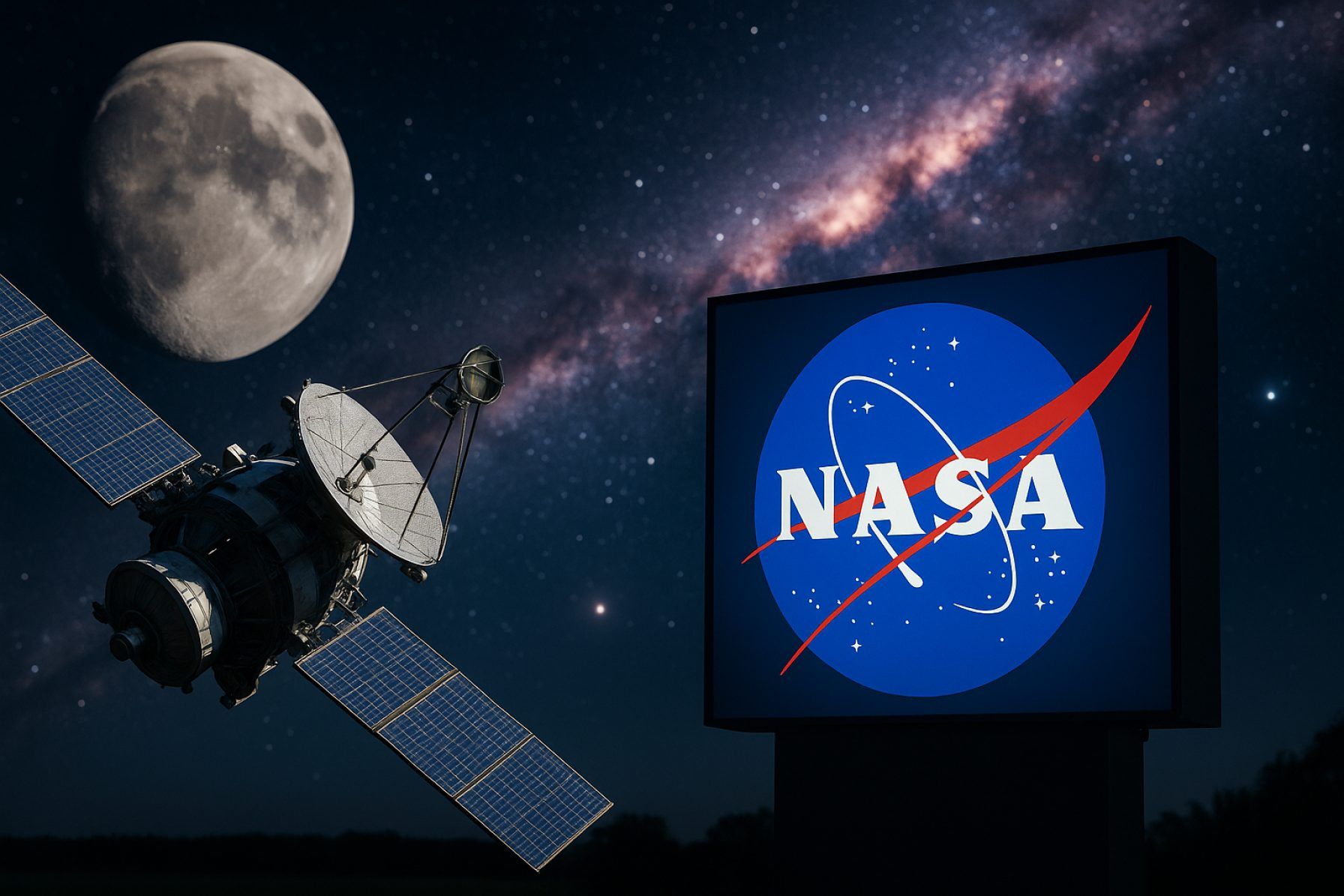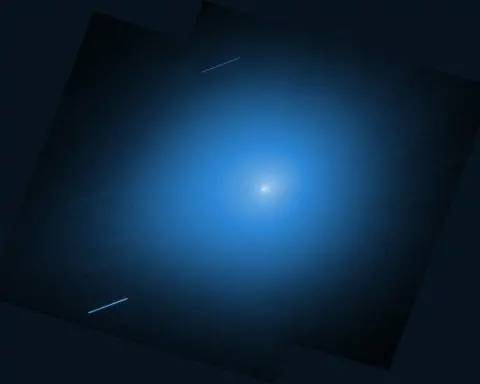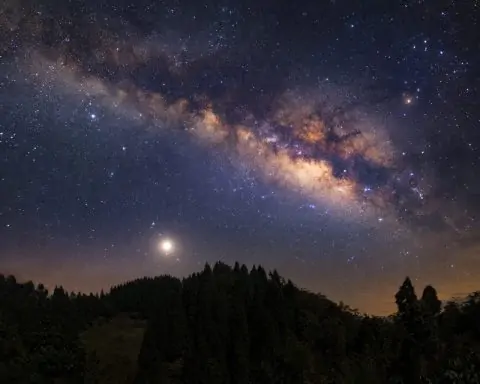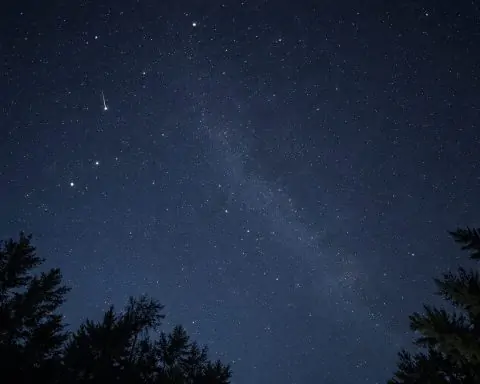- Over 2,000 senior NASA employees have resigned amid budget cuts, with a potential 25% funding reduction threatening missions, while Sean Duffy, a former congressman and reality TV star, was named interim NASA administrator and serves as both NASA administrator and Secretary of Transportation.
- An alleged Iranian missile strike destroyed a $15 million U.S. communications radome at Al Udeid Air Base in Qatar, which housed the Modernization Enterprise Terminal (MET) for secure military communications.
- Russia’s secret Nivelir project drew attention after Cosmos 2558 released a small object in orbit, a move interpreted as a possible anti-satellite test signaling space-arms concerns.
- The growth of mega-constellations has raised collision risks, with Starlink collision avoidance maneuvers more than doubling in number and Office of Space Commerce funding cuts threatening critical prevention systems.
- Starlink reported $2.7 billion in revenue for 2024, up 93% from 2023, with net profits of $72.7 million and Europe identified as the top market, driven largely by subscriptions.
- From July 15, 2025, Starlink will test satellite connectivity on select Android and iOS smartphones, including iPhone 14-16, Google Pixel 9, Samsung Galaxy A14-A54/S21-S25/Z Flip3-Z Flip6, and Motorola Razr/Edge, in partnership with T-Mobile, Verizon, and AT&T.
- The UK government pledged £140 million ($191 million) to support Eutelsat’s OneWeb LEO broadband constellation, with additional French investment to boost GEN2 satellites and the EU’s IRIS 2 programme.
- MethaneSAT, an $88 million climate mission backed by the Environmental Defense Fund with Bezos and Google support, failed after one year in orbit, though processed data will still be released.
- 3I/ATLAS became the third known interstellar object to visit our solar system, moving faster than 130,000 mph and expected to reach its closest Sun approach in October 2025, with an age estimated at 3–11 billion years.
- NASA’s Parker Solar Probe confirmed the helicity barrier in the Sun’s corona, solving the long-standing coronal heating mystery and refining models of solar wind acceleration.
NASA in Crisis: Budget Cuts, Mass Resignations, and a Reality TV Administrator
The U.S. space agency NASA faces an unprecedented leadership and workforce crisis as deep budget cuts threaten its future missions. Over 2,000 senior-level employees have resigned amid uncertainty, with many citing a lack of direction and the specter of a 25% funding reduction. The agency’s focus is shifting toward the Space Launch System, leaving Earth observation and Solar System exploration programs at risk.The leadership vacuum has been filled, at least temporarily, by Sean Duffy—a former congressman, reality TV star, and current Secretary of Transportation—appointed as interim NASA administrator by President Trump. Duffy’s appointment, despite his limited space policy experience, signals a dramatic shift in NASA’s leadership culture and possibly a move toward greater privatization of space activities, with companies like SpaceX and Blue Origin poised to take on larger roles.Duffy’s dual role as NASA administrator and Transportation Secretary has drawn both skepticism and intrigue. Trump praised Duffy’s leadership, stating, “He will be a fantastic leader of the ever more important Space Agency.” Duffy himself declared, “Honored to accept this mission. Time to take over space. Let’s launch.” ( [2], [3])“You’re losing the managerial and core technical expertise of the agency,” warns Casey Dreier of The Planetary Society, raising concerns for future lunar and Mars missions. ( [1])
Key Takeaways
- NASA faces a “brain drain” as thousands of experienced staff exit.
- Budget cuts threaten Earth science and planetary exploration.
- Sean Duffy’s appointment as interim administrator marks a new era, possibly accelerating privatization.
- The agency’s ability to deliver on Artemis and Mars missions is now in question.
Satellite Wars: Infrastructure Under Fire and the Rise of Space Militarization
Iranian Strikes Expose Satellite Vulnerabilities
Satellite imagery has become a frontline witness to modern conflict. Recent attacks on U.S. military infrastructure in the Middle East highlight the vulnerability of critical satellite communication assets. Satellite images from Satellogic and Maxar confirmed the destruction of a $15 million U.S. communications radome at Al Udeid Air Base in Qatar, following an alleged Iranian missile strike. The radome housed the Modernization Enterprise Terminal (MET), vital for secure U.S. military communications.CENTCOM acknowledged defending against the attack, but the loss underscores the risks facing satellite infrastructure in conflict zones. ( [4], [5], [6])Russia’s ‘Nivelir’ Project and the Threat of Space Weaponization
Russia’s secretive ‘Nivelir’ project has raised alarms after the Cosmos 2558 satellite unexpectedly released a small object in orbit, interpreted by experts as a possible anti-satellite (ASAT) weapon test. This “space stalking” behavior signals a new era of orbital arms competition, with NATO and space policy experts warning of the military consequences.“The project has potential military consequences,” warns Bart Hendricks. ( [7])
Satellite Collision Risks Escalate
The rapid expansion of mega-constellations like Starlink and Amazon Kuiper is increasing the risk of satellite collisions. U.S. space industry leaders warn that budget cuts to the Office of Space Commerce threaten critical collision prevention systems. The number of Starlink collision avoidance maneuvers has more than doubled, raising urgent safety concerns for the orbital environment. ( [8])Recap
- Satellite infrastructure is now a direct target in international conflicts.
- Russia’s ASAT activities and U.S. military satellite losses highlight the need for robust space security.
- Collision risks are rising as satellite numbers soar.
Starlink, OneWeb, and the Global Satellite Internet Race
Starlink’s Global Expansion and Financial Realities
SpaceX’s Starlink continues its global rollout, securing final regulatory approval to launch satellite internet services in India, joining OneWeb and Jio as authorized providers. The five-year license allows Starlink to deploy its Gen1 constellation, but commercial rollout depends on building local infrastructure and meeting security protocols. ( [9], [10])Starlink’s 2024 financials reveal $2.7 billion in revenue, up 93% from 2023, but with net profits of only $72.7 million—insufficient to fund SpaceX’s ambitious Starship program. Most revenue comes from subscriptions, with Europe as the top market. ( [11], [12])Direct-to-Cell and Smartphone Integration
Starlink is set to begin testing satellite connectivity on select Android and iOS smartphones from July 15, 2025, in partnership with T-Mobile, Verizon, and AT&T. Supported models include iPhone 14-16, Google Pixel 9, Samsung Galaxy A14-A54/S21-S25/Z Flip3-Z Flip6, and Motorola Razr/Edge. European rollout awaits local agreements. ( [13])In Ukraine, Kyivstar and Starlink will launch Direct-to-Cell satellite messaging, making Ukraine one of Europe’s first countries to offer this service. Messaging via SMS, WhatsApp, and Signal will be available initially, with mobile satellite broadband for data and voice planned for 2026. ( [14])OneWeb and Eutelsat: Europe’s Satellite Ambitions
The UK government has pledged £140 million ($191 million) to support Eutelsat’s OneWeb LEO broadband satellite constellation, with additional French investment. This boosts the network’s expansion, supports future GEN2 satellites, and strengthens Eutelsat’s role in the EU’s IRIS 2 programme. ( [15], [16], [17])Türksat’s Digital Lifeline to Syria
Türkiye’s Türksat has launched Ka-band satellite internet in Syria using the Türksat 5B satellite, enabling reliable digital public services in areas with poor infrastructure. The initiative includes internet, TV, radio, e-government tools, and emergency communications, marking a significant step in Syria’s digital transformation. ( [18], [19])Recap
- Starlink, OneWeb, and Türksat are expanding satellite internet access globally.
- Financial sustainability remains a challenge for mega-constellations.
- Direct-to-cell services and smartphone integration are the next frontiers.
Satellite Technology Breakthroughs: From Laser Links to AI and Digital Twins
Chinese Laser Satellite Surpasses Starlink
A Chinese team led by Wu Jian and Liu Chao achieved 1 Gbps data transmission from a geostationary satellite 36,000 km above Earth using a 2-watt laser, outpacing Starlink’s current capabilities. Their AO-MDR technology ensures stable signals despite atmospheric turbulence, marking a revolution in high-speed, efficient satellite communications. ( [20])AI-Powered Satellites and Digital Twins
UC Davis and Proteus Space are developing a pioneering satellite with artificial intelligence and a digital twin, set to launch in 2025. This innovation promises greater autonomy, extended lifespan, and reduced ground crew reliance, heralding a new era in real-time satellite monitoring and proactive failure prevention. ( [21])Skynopy and SpaceLocker: Plug-and-Play Space Access
Skynopy and SpaceLocker have partnered to streamline access to space and satellite data. SpaceLocker’s plug-and-play orbital containers and Skynopy’s high-speed ground station network will support the 2026 ‘Out of the Box’ mission, making satellite deployment and data retrieval more accessible. ( [22])Spoutniks Unveils Next-Gen CubeSat Platform
Spoutniks introduced its new SG3 CubeSat platform, scalable from 2U to 16U, featuring enhanced orientation, high-speed S-band link, and onboard AI processing. The company has already launched 90 of its 150 satellites for clients, demonstrating rapid growth in the smallsat sector. ( [23])Recap
- Laser communications and AI-driven satellites are redefining space technology.
- Plug-and-play and modular platforms are making space more accessible.
- China and private startups are leading in satellite innovation.
Earth Observation and Climate Satellites: Progress and Setbacks
MethaneSAT: A Climate Mission Lost
MethaneSAT, launched by the Environmental Defense Fund with backing from Bezos and Google, has failed after just one year in orbit. Designed to track methane emissions globally, the $88 million mission provided unprecedented precision in methane monitoring. Despite the loss, data collected will still be processed and released, but the setback is significant for climate regulation efforts. ( [24], [25], [26], [27])TANGO Satellites: Monitoring CO2 from Space
The Netherlands will launch two TANGO satellites capable of measuring CO2, methane, and NOx emissions from individual factories. These satellites will verify if countries and companies meet climate commitments, providing certainty for compliance with the Paris climate agreement. ( [28])Copernicus and Sentinel-1C: Upgrades for Environmental Action
The Copernicus Land Monitoring Service has boosted forest map resolution from 100 to 10 meters, aiding reforestation and land management. The newly launched Sentinel-1C satellite extends the Copernicus mission, providing high-resolution radar images to monitor Earth’s changing environment and support scientific research. ( [29], [30])SatVu: High-Resolution Thermal Data for Europe
British company SatVu has secured a €3 million contract to supply high-resolution thermal satellite data for three years. Their HotSat satellites can monitor Earth’s surface day and night, enhancing climate monitoring, resource management, and security across Europe. ( [31])ICEYE: Disaster Response in Brazil
ICEYE supported Rio Grande do Sul’s flood response by supplying high-precision SAR satellite images, enabling rapid mapping of flood extent and depth. This data accelerated emergency protocols and aid distribution. ( [32])Recap
- MethaneSAT’s failure is a blow to climate monitoring, but new missions like TANGO and SatVu are stepping up.
- Copernicus and Sentinel-1C upgrades are enhancing environmental data for Europe.
- Satellite data is increasingly vital for disaster response and climate compliance.
The Milky Way’s Hidden Companions: 100 Undiscovered Satellite Galaxies?
A series of studies from Durham University and international collaborators have upended our understanding of the Milky Way’s structure. Advanced simulations suggest our galaxy could have 80 to 100 more satellite galaxies than previously observed—potentially doubling the known count. This finding strongly supports the Lambda Cold Dark Matter (ΛCDM) theory, the standard model of cosmology.The challenge now is detection: these faint “orphan” galaxies are difficult to observe, and current models cannot indicate exactly where to search. Upcoming telescopes and surveys may soon reveal these missing companions, reshaping our view of the Milky Way’s formation and dark matter distribution. ( [34], [35], [36], [37], [38])“If our predictions are correct, this will provide further confirmation of the ΛCDM theory of structure formation and evolution in the Universe,” said lead researcher Isabel Santos-Santos. ( [33])
Recap
- The Milky Way may host up to 100 undiscovered satellite galaxies.
- This supports the ΛCDM model and could solve the “missing satellites” problem.
- New telescopes are needed to confirm these predictions.
Solar System Surprises: Interstellar Visitors and Solar Mysteries
3I/ATLAS: The Third Interstellar Object
Astronomers have identified 3I/ATLAS, only the third known interstellar object to pass through our solar system. Detected by NASA’s ATLAS survey, it is racing through the solar system at over 130,000 mph and will reach its closest point to the sun in October 2025. Its age is estimated at 3–11 billion years, making it far older than previous visitors Oumuamua and Borisov.NASA’s James Webb and Hubble telescopes are expected to reveal its size, composition, and origins in the coming months. ( [43])“This thing is traveling pretty fast,” said Paul Chodas of NASA’s JPL. ( [39], [40], [41], [42])
Parker Solar Probe Solves the Coronal Heating Mystery
NASA’s Parker Solar Probe has confirmed the existence of the “helicity barrier,” a magnetic structure in the Sun’s corona that helps explain why the outer atmosphere is millions of degrees hotter than the surface. This discovery solves a decades-old mystery and has major implications for understanding solar wind acceleration and predicting space weather.“The helicity barrier links the two theories and resolves each of their individual problems,” explains Dr. Romain Meyrand. ( [44], [45], [46], [47])
Recap
- 3I/ATLAS is a rare interstellar visitor, offering clues to the galaxy’s history.
- Parker Solar Probe’s findings may revolutionize solar physics and space weather forecasting.
The James Webb Space Telescope: Three Years of Cosmic Revelations
NASA’s James Webb Space Telescope (JWST) has transformed astronomy in just three years. It has revealed unexpectedly bright early galaxies, massive black holes, and new galaxy types like “Little Red Dots.” Webb has collected 550 terabytes of data and inspired over 1,600 research papers, far exceeding expectations.To mark its third anniversary, JWST released a dazzling infrared image of the Cat’s Paw Nebula (NGC 6334), revealing intricate, never-before-seen details of this star-forming region. The findings will inform future research on star formation and nebular regions. ( [48], [49], [50], [51])Recap
- JWST is rewriting cosmic history with unprecedented data and images.
- Its discoveries are raising new questions about galaxy formation and evolution.
Solar Eclipses and Celestial Events: Mark Your Calendars
2026 and 2027: The Great Eclipses
- 2026 Total Solar Eclipse: Occurs on August 12, 2026, visible from eastern Greenland, western Iceland, and northern Spain. High demand is expected, especially in Spain and Iceland, due to rarity and limited accommodations. Book early to secure a spot for this rare astronomical event. ( [52], [53], [54])
- 2027 Total Solar Eclipse: On August 2, 2027, the eclipse will last an extraordinary six minutes and 23 seconds, with the path of totality spanning southern Spain, North Africa, and the Arabian Peninsula. ( [55])
- 2027 Annular Eclipse in Argentina: Argentina will experience a spectacular annular solar eclipse—the “ring of fire”—on February 6, 2027. The annular phase will last nearly eight minutes. ( [56])
MESOM: Artificial Solar Eclipses Every Month
A UK-led mission, the Moon Enabled Sun Occultation Mission (MESOM), aims to use a small satellite to create artificial solar eclipses in space every month, enabling up to 48-minute observations of the Sun’s corona. ( [57])Recap
- The next two years will feature rare and long-duration solar eclipses.
- Artificial eclipses in space may soon become a reality, revolutionizing solar research.
The July Full Moon: Buck Moon and the Moon Illusion
The July full moon, known as the Buck Moon, peaked on July 10, 2025. It is one of the most distant full moons of the year and coincides with a major lunar standstill, making the Moon appear lower and larger on the horizon—a phenomenon known as the Moon Illusion. ( [58], [59])The Buck Moon is visible worldwide, with the best views at dusk as it rises in the east. The name refers to male deer growing new antlers during this time. ( [60], [61], [62], [63])Recap
- The Buck Moon offers a stunning skywatching opportunity and a chance to witness the Moon Illusion.
- July’s full moon is tied to ancient traditions and modern astronomical interest.
Martian Meteorite NWA 16788: The Ultimate Space Collectible
The largest Martian meteorite ever found on Earth, NWA 16788 (54 pounds), will be auctioned at Sotheby’s on July 16, with bids expected to reach up to $4 million. Discovered in Niger in 2023, this rare 4.5-billion-year-old rock offers unprecedented scientific insights into Mars. Fewer than 400 Martian meteorites exist, making this a truly unique space collectible. ( [64], [65], [66], [67])Recap
- NWA 16788 is the largest Martian meteorite ever found.
- Its auction is a milestone for collectors and planetary scientists alike.
Outlook: The Next Frontiers in Space
What to Watch
- NASA’s future: Will the agency recover from its current crisis, or will privatization reshape U.S. space exploration?
- Satellite security: As space becomes a contested domain, expect more incidents involving satellite infrastructure.
- Mega-constellations: The race for global internet coverage will intensify, but sustainability and collision risks loom large.
- Hidden galaxies: New telescopes may soon reveal the Milky Way’s missing satellites, reshaping our understanding of dark matter.
- Interstellar visitors: 3I/ATLAS and future objects will offer rare opportunities to study material from beyond the solar system.
- Solar mysteries: Parker Solar Probe and artificial eclipses will deepen our understanding of the Sun and space weather.
Bullet Recap
- NASA faces a leadership and workforce crisis amid deep budget cuts.
- Satellite infrastructure is increasingly targeted in global conflicts.
- Starlink, OneWeb, and Türksat are expanding satellite internet, but financial and regulatory hurdles remain.
- Laser communications, AI, and modular satellites are revolutionizing space technology.
- MethaneSAT’s failure is a setback, but new climate satellites are on the way.
- The Milky Way may host 100 undiscovered satellite galaxies.
- Interstellar object 3I/ATLAS is racing through the solar system.
- Parker Solar Probe has solved a key solar mystery.
- JWST continues to deliver cosmic surprises.
- Rare solar eclipses and the Buck Moon offer celestial spectacles.
- The largest Martian meteorite is set for auction.
Final Thoughts
Space is entering a new era—one marked by technological leaps, fierce competition, and unprecedented challenges. As NASA navigates internal turmoil, private companies and international players are racing ahead. The next few years will be pivotal, not just for those who look to the stars, but for everyone on Earth who depends on the technologies and discoveries that orbit above us.For more details and original reporting, explore the linked sources throughout this article.nn
Complete List of Reference Sources
References
1. timesofindia.indiatimes.com, 2. www.foxnews.com, 3. time.com, 4. www.bostonglobe.com, 5. www.independent.co.uk, 6. timesofindia.indiatimes.com, 7. asharq.com, 8. www.noobz.ro, 9. www.telecomreviewasia.com, 10. www.extremetech.com, 11. wccftech.com, 12. au.pcmag.com, 13. www.money.it, 14. www.thefastmode.com, 15. www.ispreview.co.uk, 16. www.satellitetoday.com, 17. timesofindia.indiatimes.com, 18. www.hurriyetdailynews.com, 19. trt.global, 20. www.drivingeco.com, 21. brasil.perfil.com, 22. www.spaceconomy360.it, 23. kosmosnews.fr, 24. www.space.com, 25. www.onegreenplanet.org, 26. www.newscientist.com, 27. www.epochtimes.com, 28. nos.nl, 29. www.wired.it, 30. www.spacepage.be, 31. biznesalert.pl, 32. teletime.com.br, 33. naukatv.ru, 34. www.bbc.com, 35. www.miragenews.com, 36. www.thenorthernecho.co.uk, 37. earthsky.org, 38. greensavers.sapo.pt, 39. www.nytimes.com, 40. www.livescience.com, 41. science.nasa.gov, 42. www.esa.int, 43. www.yahoo.com, 44. www.iflscience.com, 45. thedebrief.org, 46. www.spacedaily.com, 47. dailygalaxy.com, 48. science.nasa.gov, 49. www.space.com, 50. www.universetoday.com, 51. www.upi.com, 52. www.forbes.com, 53. www.inkl.com, 54. www.space.com, 55. www.capetownetc.com, 56. noticiasambientales.com, 57. www.universetoday.com, 58. www.independent.co.uk, 59. www.iflscience.com, 60. www.goerie.com, 61. www.bournemouthecho.co.uk, 62. www.desertsun.com, 63. www.newson6.com, 64. www.cnn.com, 65. www.marthastewart.com, 66. unionrayo.com, 67. www.forexfactory.com










